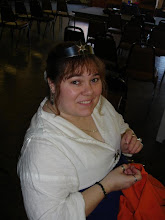 The Lowly Bauble: A Tool of Fools
The Lowly Bauble: A Tool of FoolsFrom the Webster’s dictionary…Bauble: 1) A small showy ornament of little value; a trinket. 2)Archaic: A mock scepter carried by a court jester. Middle English: babel, from old French, meaning plaything.
In picturing a fool from the 13th to the 16th century, it is often seen in pictures as a person dressed in motley (parti-colored clothes), a belled hat, and carrying a scepter with a model of a head on it. Searching through different sources, I came across many paintings and illuminations of fool’s with these scepters. They are often shown as being just the head, covered in a hat that usually matches the clothing of the fool in the picture. In the Bible du XIIIe siecle, there is an illuminated page showing a fool in a yellow hat with ears on it and the head of a bird on the top of the hat. He is carrying a scepter that is matched to his hat, including the bird shape on top. However, in the Grimani Breviary, known as the codex, an illumination there shows a fool with almost corn-rowed hair carrying a bauble that has a hood while he himself does not. In the painting The Ship of Fools, by Hieronymus Bosch, there are many foolish people portrayed, and one true fool. He has a bauble that is more like a staff in its length. It is also topped by a head with a similar hat to the fool pictured.
For building my bauble, I relied most heavily on two actual baubles that are housed in the Nurnberg Museum in Germany. Both baubles have ivory heads and are dressed in brocades and velvets with bells on the ends of the dags that surround the heads. I used clay instead of ivory since there are many extant examples of dolls and toys created from clay and it was the most cost effective material I had at hand. I believe that it is still a good choice as it might have been used for less opulent baubles. Clay, now as then, is still a durable material that allows great detail, but is easier to obtain than ivory. The clay I used was an air hardening clay with the look and feel of a terra cotta clay. I would have loved to use real terra cotta, but as I do not have current access to a kiln, I made do.
For the hood and “body” of my bauble, I chose to use cotton fabrics for the cost, but the prints where chosen for fun, not period “proper-ness”. The colors of black and white are our Barony’s colors, and as this fool was being made for our local “Fool’s Revel” the colors and patterns were appropriate. I painted the face in gauche/watercolor paints and then protected it with a natural varnish. I tipped the ends of the dags with bells just as the two examples showed. I ended up making two, one as a gift to our stepping down “Baronial Fool” and one to keep as they came out so neat.
References:
The Weidner 13th Century Bible http://www.leavesofgold.org/learn/children/slideshow/widener2_text.html
Bible du XIIIe siecle
King David and a Fool by the workshop of the Master of the Echevinage de Rouen, France, Rouen, c. 1465-75
The Free Library of Philadelphia, Rare Book Department, Widener 2, fol. 290
The Web Gallery of Art http://www.wga.hu/index.html
Grimani Breviary1490-1510
Illumination on parchment; Biblioteca Nazionale Marciana, Venice
The Ship of Fools: Hieronymus Bosch 1490-1500
Oil on wood, 58 x 33 cm; Musée du Louvre, Paris
http://www.fathom.com/feature/122350/ Fooling Around the World: The History of the Jester. From University of Chicago Press, by Beatrice K. Otto.




No comments:
Post a Comment